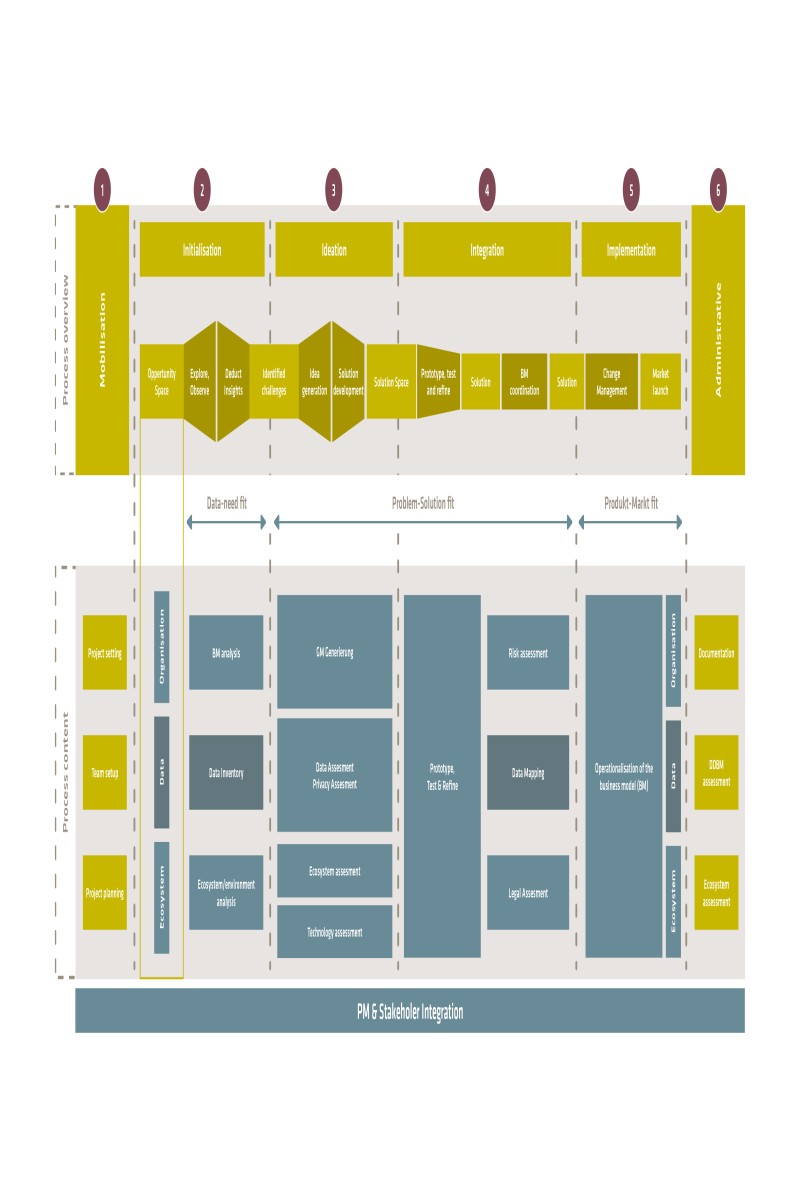24. February 2021 By Louisa Burakowski
Data as a key resource – the process for data-driven business model innovation
As a result of the digital transformation, which can be seen in all industries, companies now generate and collect huge amounts of data. More and more, companies want to get real value from this data, not just collect it. A new approach is needed to unlock this potential in companies.
Some companies are already profiting from the use of their data. However, the majority of initiatives still focus on optimising internal processes and costs, while the potential of data to transform previous business models often falls by the wayside. In this process, entire components of business models can be shifted or expanded with the help of data. The use of data can also lead to innovative new business models.
New paths to a sustainable and digital future
Companies are innovative not only when they introduce new products or services, but also when they develop new ways of creating and proposing value. In this context, holistic innovation management empowers companies to create a progressive and sustainable future that promotes the digital transformation of business models.
The path towards this goal has been developed in the ‘data-driven business model innovation (DDBMI) process’ developed by researchers from KIT. This model combines the needs of data-driven business models with the potential of innovation management.
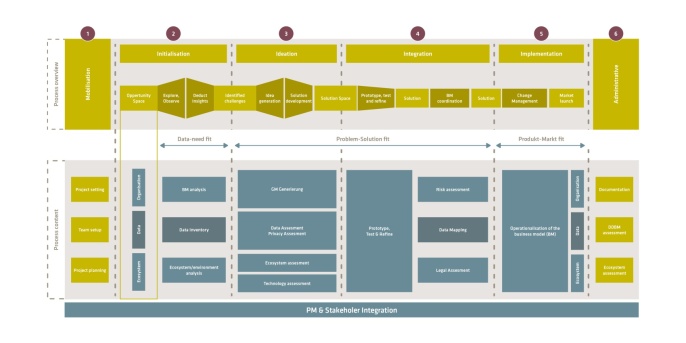
The model is based on two layers – process overview and process content. The process overview layer focuses on the process flow and describes the individual innovation phases, their content and outputs, while the process content focuses on the organisation, data and ecosystem.
In the following, we will describe the individual phases and their associated layers and dimensions of the ‘data-driven business model innovation (DDBMI) process’ in more detail. There are six phases in total to be considered iteratively:
Phase 1: Mobilisation phase
The process starts with the mobilisation phase. This phase focuses on fundamental aspects and includes project planning, assembling the project team, and setting up a project with the goal of developing data-driven business model innovation.
Phase 2: Initiation phase
The goal of this phase is to develop an understanding of the status quo, an overview of the company situation, customer needs and players, and technologies in the ecosystem through observations and analyses. From the analysed insights, a holistic understanding of the current situation and challenges is generated on which the ideation phase will be based.
The dimensions come into play for the first time in the initiation phase. The ‘organisation’ dimension of the current business model of the company will be analysed.
In addition to the analysis of the current business model, the data inventory is analysed along with the available data sources within the framework of the data dimension.
The ‘ecosystem’ dimension is also examined using an environment analysis. In the analysis, all the players within the company and the relationships within each ecosystem are observed and analysed. For example, customers, partners, competitors and other stakeholders that are relevant to the company are identified. It is also important at this stage to analyse the system environment and the technological basis of the ecosystem.
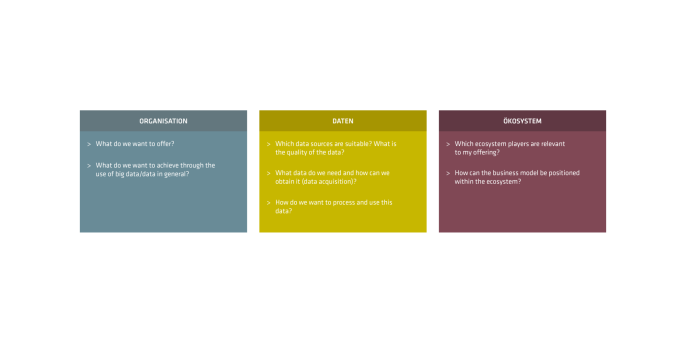
Phase 3: Ideation phase
After focusing mainly on the assessment and analysis of the current situation the initiation phase, the ideation phase is clearly characterised by a creative mindset. The goal of this phase is to generate different DDBM concepts, taking into account the available data sources and their quality. In line with innovation management, ideas leading to solution strategies are developed in this phase based on the problem statement and the previously defined challenges. The result is a Solution Space, which contains the contents and the ‘WHAT’ of the respective solutions.
In addition to the development of ideas and/or business models, the technical and legal framework conditions for the process content (for example, data protection) must be taken into account when using the data. Decision-makers need to consider the extent to which the new DDBM will benefit the company’s current offering or whether it makes sense to create an entirely new offering. The role the ecosystem in the given business model is also evaluated. This is because, in addition to competitive relationships, the ecosystem also offers potential for cooperation between individual players and can lead to joint value creation.
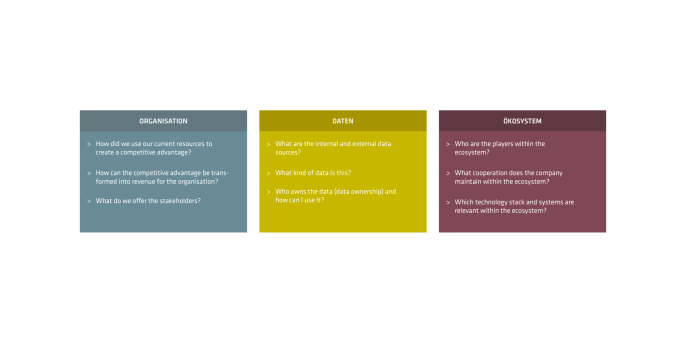
Phase 4: Integration phase
In the integration phase, the DDBM is further developed and improved and adapted according to the sub-steps ‘prototyping’, ‘testing’ and ‘refining’. This phase aims to explore and optimise the acceptance and functionality of the solution strategies using (low and high fidelity) prototypes. The guiding principle ‘fail often, fail early’ that we know from design thinking applies in this phase, allowing a coordinated concept to emerge in the iterative steps.
The next step ultimately leading to implementation is the risk assessment of the DDBM. The sooner risks are identified (such as lack of employee skills, data integrity and so on), the greater the chances of successful implementation. Also, the data transfer processes involved (in this case, data mapping) should be discussed in more detail to ensure the seamless use of the data. In doing so, it is also important to evaluate the DDBM against external influences, such as legal and regulatory conditions, so that the business model innovation can be adjusted if necessary.
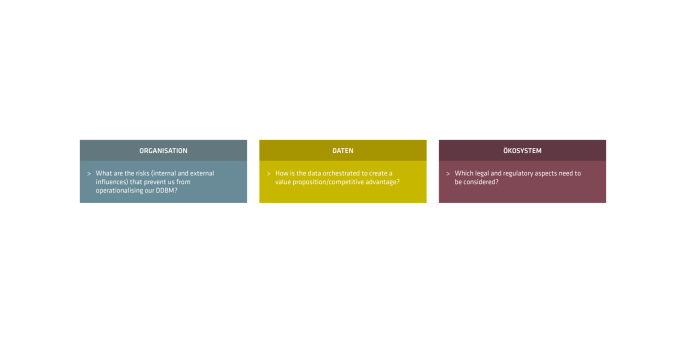
Phase 5: Implementation phase
The implementation phase focuses on the operationalisation and finally on the market launch of the DDBMI. The first step in the implementation phase is to ensure that the transformation and the associated change management are well planned. This includes holistic education as well as the onboarding and training of the players involved. This helps eliminate silo mentalities and establish a compatible corporate philosophy that promotes innovation. When operationalising, the product-market fit needs to be considered. In addition, plans need to be made for testing the concept and adapting it if necessary.
Phase 6: Administration phase
The sixth and final phase of the DDBMI process concerns the management of the DDBMI. After the launch, the focus shifts to documenting the best practices and lessons learned during the process. This can help to improve and adapt the process for future DDBMIs over the long term, thereby promoting sustainable innovation. This phase also includes the ongoing evaluation of the newly created DDBMI and ecosystem. The aim is to identify internal and external influences on the DDBMI at an early stage and be able to adjust the business model if necessary.
Conclusion
We have introduced you to the DDBMI process model in order to give you an idea of how companies can integrate data as a key resource into their day-to-day business and their business strategy. As you have seen, the model allows for a holistic view of business models, integrating data and aspects specific to innovation.
Does your company already consider data a key resource in keeping with the motto ‘data is the new oil’? Or do you want to learn more about data and innovation management? Get in touch with us! We look forward to sharing ideas and experiences and will be happy to support you in all your challenges.
Would you like to learn more about exciting topics from the world of data and analytics at adesso? Then check out our website. You will find more exciting topics from the adesso world in our previous blog articles.


